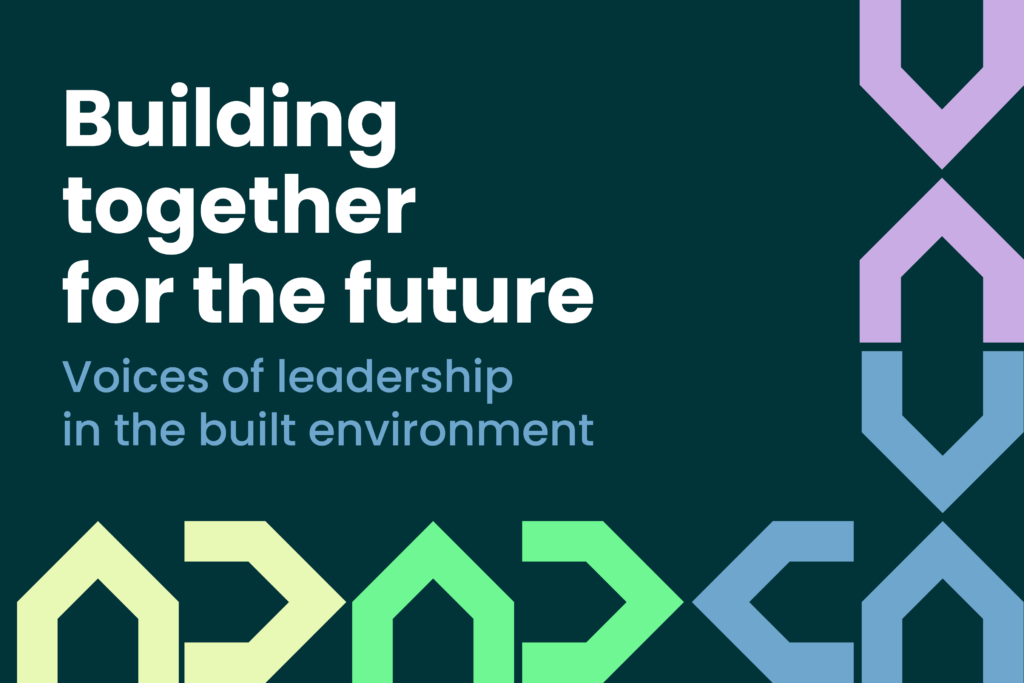
We are acutely aware of the narrative of change and growth within the UK, and wanted to understand what this means in actual and aspirational terms through discussions with a select group of senior voices from the Built Environment. Our timing is intentional to coincide with the recent election and we’ve focused on five key areas which we believe are important to consider as we look to the future.
We will cover these topics and share the most pertinent themes over the next few months, with the views of those senior leaders and our own perspectives and expertise entwined. We have found the points of inflection most interesting, and welcome your reflections on what we share.
Our team has a depth of experience across the built environment, talking to and working with leaders and industry to support success, continuity and long-term community commitment across the sector. For our first piece we wanted to focus on the Bright Spots. What are the things that give leaders in this space the energy to do what we do and the optimism to continue doing it?
We are grateful to our contributors for their valuable insights, including:
- Hugh Seaborn, Chief Executive of Cadogan Estates
- Professor Yolande Barnes, Chair of the Bartlett Real Estate Institute at UCL
- Richard Donnell, Executive Director of Houseful
- Emily Cox MBE, Chair of Gentoo Group
- Andy Hulme, Group Chief Executive Officer of The Hyde Group
Focus Areas for the Future
The start of a new political administration invokes a period of reflection, it urges us to think about the future, often generating a range of mixed feelings. One of the very important focus points for the future in the UK is the built environment – where we live, work, gather and thrive. This has been a key theme of the Labour administration, whether it be housing, how and where we work and the impact of the climate on both those things.
An emphasis on a new and collegiate approach presented by the Labour administration appears to offer hope and opportunity in this sector, and this is a tone and thread we were met with in our interviewees. Of course, there are challenges, and a lot of pragmatism, but we want to start with assessing the ‘bright spots’ in the built environment sector – of which we were pleased to hear there are an increasingly good number.
We are mindful that with the report into what contributed to the tragedy at Grenfell due to be issued as we write this, we cannot hide from the difficulties and challenging conversations facing the broad Built Environment sector. It is important, we believe, that this does not just bring a focus to what went wrong; we need to be looking at what can and is being done differently and where there is positive change and renewed emphasis on community building and safety.
Welcoming intention with open arms
The overriding message from across our interviewees was to welcome the intention and tone being set by the new Labour government in the UK, with regards to the built environment. A government which has already made its intentions about building more houses very clear, but also shown greater desire to encourage regional and local focus to support community and more empowered decision-making. The emphasis on community and its importance in delivering genuine place-making agendas has been on the agenda in this sector for many years, but the mechanisms to translate that have been challenging. It is not to say there is an overnight panacea but a more open dialogue is being welcomed.
One comment summarised that: “the new administration seems to understand the pieces of the jigsaw better” reflects our conversations well and illustrates an important paradigm: this requires thought, careful placing and more often than not, teamwork, to complete the picture. Economic growth is very high on the agenda, and there is no doubt about that, and “the seemingly entrepreneurial mindset from Government” was lauded as an opportunity to help join up the system.
People and place are far more than numbers of houses
Ambition and commitment to building more homes is welcome, no one we talked to disagreed with that. But these must be the right kind of homes, that are affordable, sustainable and focused on creating places where community and the environment can thrive. The emphasis on bricks and mortar and neighbourhood “has become significantly greater since the pandemic” and we need to see that as an opportunity to enhance lives.
In recent years tragedy such as Grenfell and the death of Awaab Ishak in Rochdale, have focused minds on specific and vital issues, particularly for the Housing Association sector. It has also widened conversations on the types of homes and materials being used right across housing development. It has placed a spotlight on the importance of tenancy and customer service – a focus that comes with a greater sense of purpose and commitment to improving lives and ensuring communities feel empowered and heard. A focus regionally will help this it was agreed, a view shared by those we spoke to: “We can start rebuilding in the UK, build back our communities and a greater sense of pride. We want our stock to be here for the next 100 years, and that requires quality, consideration and commitment.”
For this to work, a shift in how land and space is valued is crucial. We need to move from development purely as a driver of economic growth or best financial returns. One interviewee reflected: “We need to consider land as environmentally valuable, socially valuable and not just financially valuable”. This means a greater focus on the overall balance sheet and not just growth. Resurfacing entire streets, not just mending potholes. Planting and supporting, biodiversity, not just building as many houses as possible.
Cross cutting collaboration and communication
The ambitions of place and purpose are evident right across the organisations, public, private, not for profit and academic, which exist in the built environment. The breadth of those we spoke to and work with shared and lauded this view. The regional focus being discussed at Government level was welcomed in this context and would, it is hoped, drive far greater and much needed collaboration across the sectors.
Moving from a fully centralised model was considered favourable, and while there were varying thoughts on the merits of full devolution of funding to regional authorities, the “ability to make more decisions and flex more quickly” was considered significant and beneficial.
The ability to create greater interaction between housing, planning and regeneration and infrastructure, not just at an administrative level, but through more consortia, network and addressing challenges through shared learnings and examples at regional and national will help to create a more sustainable and harmonious ecosystem where people come first. “We want to share to help others do well, which will also reduce consolidation and mergers and acquisitions. That isn’t good for the market and slows everything down.”
An expanded approach to cross-sectoral working should be “welcomed and not inhibited” one interviewee proposed, with another suggesting that genuinely engaging in this manner will have much wider positive consequences on “skills development, education, and health and wellbeing more broadly.”
And for the whole of society and environment, “the collective endeavour to move towards net zero with a greater emphasis on sustainability” was welcomed with many “pushing forward together to move the dial.” The built environment is a large contributor to carbon emissions in this country, but there is genuine innovation underway and a greater ability to share and learn from others and break down barriers will be vital in achieving positive and necessary outcomes for all.
Long-termism is the way of the future
We have a long tradition of building and place making in the UK, and many communities based around significant structures and houses that have stood for centuries. But this approach to construction and building has waned in recent decades and is a redundant model. All of our interviewees agreed and summed up well by one: “Can we actually think longer term and how places are considered for their potential of future refurbishment, repurpose or reuse, rather than a carbon sink.”
The increased move to funding and efforts being put into in decarbonising, urban greening and enhancing biodiversity was highlighted as essential in the long-term, and crucially engaging communities and giving them an opportunity to enjoy and benefit from it.
Long-term ambition requires supporting and championing of the people working so hard in these sectors who exude passion and genuine purpose and this should be a long term view – retaining and empowering colleagues to do their best and be proud. This is a point that all of our interviewees were hugely clear on. And it must extend across all areas and governance is vital – more thoughtful executive and non-executive leadership to better reflect the communities they exist within is not a nice to have, but a long-term necessity.
As trusted advisers in the senior leadership space, our takeaway is that for leaders to thrive they need to be supported by their Board and at a macro level with clarity of direction, a favorable operating environment and policy makers who think beyond money. The built environment is a complex eco-system where things need to be in balance for it to thrive.
Despite the challenges of the last few years we have seen leaders in this space, innovate, think long term with brilliant results and with the fair wind that is blowing behind the sector more of that should be possible in the coming months and years.
All chapters:
Chapter 2 – Industry obstacles and how we can challenge them together
Chapter 3 – A post-budget insight
Chapter 4 – Priorities for the next decade
Committed to Leadership Excellence in the Built Environment
Our Built Environment practice group is committed to finding and supporting excellent and authentic leaders across infrastructure, local and regional development, housing and transport to deliver tangibly positive benefits for existing, emerging and new communities across the UK. To find out more about how we can support your organisation’s leadership development and appointments, please get in touch with Vidhu Sood-Nicholls or Hannah Scarisbrick in our team.


